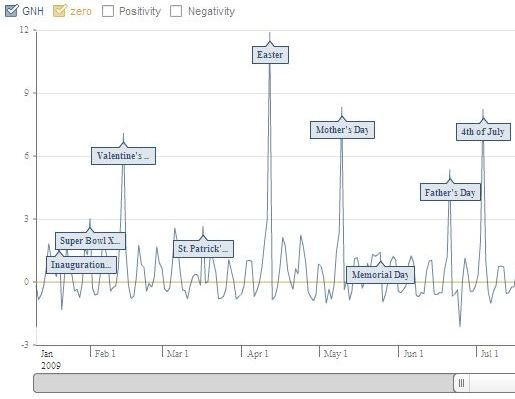I love it when the Interweb helps answer a persistent question like “how happy are we?”
It’s a serious question—evaluating the well-being of a place—and one that Sightline has spilled a lot of cyber-ink on over the years. France may soon embark on the largest national measurement of what has been dubbed “gross national happiness.” But now it turns out that the United States may already have a halfway decent measurement available—and it’s on Facebook of all places.
Check it out:

No kidding, Facebook really does have something like a daily trend line for American happiness. (Be sure to play around with some of the features, especially the x-axis.) It’s far from a perfect measurement, to be sure, but it represents an aggregation of a huge amount of user-supplied data that must be the envy of social scientists everywhere.
And speaking of Facebook, you should get yourself over to Sightline’s Facebook page. That’s where all the cool kids are hanging out.




eldan
I love this idea, but I think we need a cleverer way of scoring than that facebook page uses. The variation over a 24-hour period got me wondering about the nation of morning people, and then suddenly I realised what was going on: every day spikes in the morning with the inevitable deluge of “Happy birthday/anniversary/Monday” wishes (and a bigger spike for “Happy Easter” etc), and then dips in the evening with “I’m so tired”, “work sucked today” and so on…. This isn’t directly that big a problem—we can deal with it by looking at daily averages and ignoring holidays—but I think it points to a general problem with confounds.
Matt the Engineer
I think the variation you’re seeing is weekly, not daily. As in “Yay! the weekend!”… “Uh. Monday”
jeffy
Yeah, at the zoomed-in end of the scale it really seems to imply that we love to have time off (or hate our jobs…)I was struck by the pretty clear trend line when you look at just the negativity scale and squash the whole data set into the view (by stretching out the scroll widget). Is that the start of an upward trend in negativity in the last couple weeks? Unfortunately the holiday spikes flatten out the line for the positivity and GNH scales, but it looks like there’s an uptick there as well. Hmm.If you overlay positivity and negativity and look at the whole range it seems that they’re following the same trend which I guess we’d need to know more about what they’re measuring to understand the meaning of.
eldan
Matt: oops, you are correct. Embarrassingly, I think this significantly undermines the point I was making. The spikes for holidays may still be a problem, but at worst those could be dealt with by ignoring the days in question.
Matt the Engineer
I think we can learn enough from the posted data alone how to dramatically increase GNH:1. Increase the number of weekend days.2. Declare every day to be Thanksgiving.
Eric de Place
Jeffy–Not being a regular FB user, I’m not entirely sure what this means, but this text (same page as the chart) appears to be an explanation for the increase in negativity that you observed:”You may notice that Positivity and Negativity are going down over time—that’s because as Facebook grows, there is more variability in the Facebook demographic and how people use status updates (using more or less emotional words).”
Michelle
Hmmm…I’m not a FB user (am I showing my age here?), but, from what I’ve heard from the media, it’s basically a social networking sight that’s used MOSTLY by the younger generation (i.e., grade school and college age kids). Though, that’s gradually changing as more of the “older generation” hop on!So, now that summer vacation is over and school is back in full session, it could be that moods are now swinging towards TGIF and Thanksgiving break…I’m with Matt The Engineer: Let’s have longer weekends and more holidays! 🙂
Eric Hess
According to user stats from July, only 40% of Facebook users are 25 or younger, with 35 and older having the fastest rates of growth.Of course, it’s quite possible that younger users update more frequently.
Michelle
…Or have greater mood swings! 😉